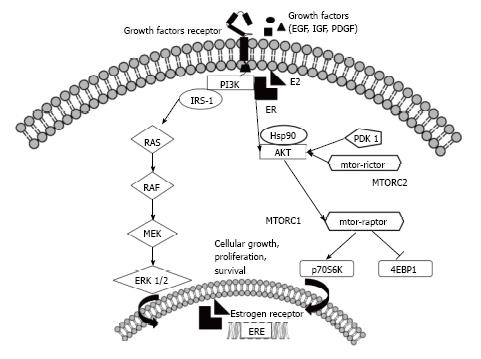Copyright
©2014 Baishideng Publishing Group Inc.
World J Clin Oncol. Dec 10, 2014; 5(5): 990-1001
Published online Dec 10, 2014. doi: 10.5306/wjco.v5.i5.990
Published online Dec 10, 2014. doi: 10.5306/wjco.v5.i5.990
Figure 2 A representation of the molecular crosstalk between estrogen receptor and the receptor tyrosine kinases and PI3K-Akt-mTOR axes.
In breast cancer, the PI3K-Akt-mTOR pathway modulates responses to signals communicated through growth factor receptors and the estrogen receptor (ER), and this crosstalk is important for sensitivity to anti-endocrine therapy. In particular, Akt and ERK1/2 phosphorylate ER on key residues involved in the induction of ligand-independent activation of DNA transcription. Furthermore, the converse occurs: estradiol, bound to membrane ER, interacts with and activates a regulatory subunit of PI3K. The mammalian target of rapamycin (mTOR) signaling cascade is another key regulatory pathway that controls proliferation and survival in cancer cells and plays an important role in the molecular crosstalk with the ER pathway. Two mTOR-interacting proteins, raptor and rictor, define distinct branches of the mTOR pathway: mTOR complex 1 (mTORC1) and mTOR complex 2 (mTORC2). Both active mTORC1 (via the phosphorylation of downstream targets, such as 4E-BP1 and p70S6 Kinase) and active mTORC2 contribute to promoting cellular survival and proliferation. EGF: Epidermal growth factor; IGF: Insulin-like growth factor; PDGF: Platelet derived growth factor; PI3K: Phosphatidylinositol-3-phosphate kinase; E2: Estradiol; IRS-1: Insulin receptor substrate-1; RAS–RAF–MEK–ERK: Mitogen activated protein kinase pathway; HSP90: Heat shock protein 90; PDK-1: Pyruvate dehydrogenase lipoamide kinase isozyme 1; p70S6K: Protein 70S6 kinase; 4EBP1: Eukaryotic translation initiation factor 4E-binding protein 1; ERE: Estrogen response element.
- Citation: Milani A, Geuna E, Mittica G, Valabrega G. Overcoming endocrine resistance in metastatic breast cancer: Current evidence and future directions. World J Clin Oncol 2014; 5(5): 990-1001
- URL: https://www.wjgnet.com/2218-4333/full/v5/i5/990.htm
- DOI: https://dx.doi.org/10.5306/wjco.v5.i5.990









